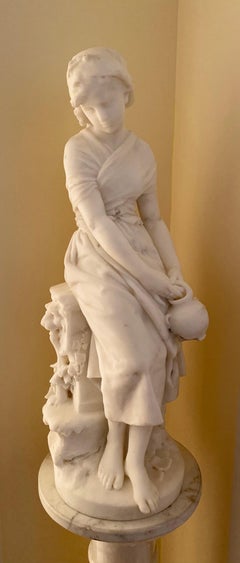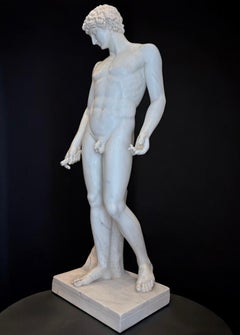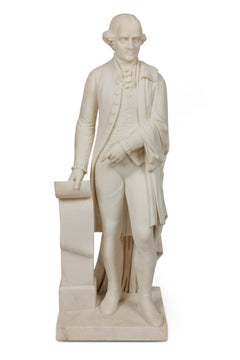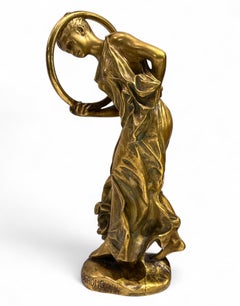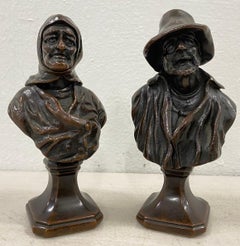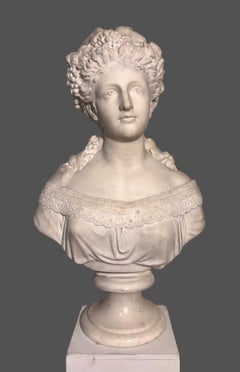19th Century Figurative Sculptures
to
48
213
108
137
66
45
Overall Width
to
Overall Height
to
172
569
2,198
7,503
69
43
104
114
60
122
201
175
216
268
58
6
4
2
2
1
448
324
322
276
264
157
107
69
53
41
33
20
17
16
14
13
11
11
10
10
398
387
127
115
41
27
16
7
7
7
366
202
Period: 19th Century
THE SPRING
Located in Los Angeles, CA
Beautiful La Belle Epoque marble in nive vintage condition.
Mathurin Moreau (1822-1912) was a French sculptor in the academic style. He was born in Dijon, first exhibited in the 1848 Salon, and finally received a medal of honor...
Category
Academic 19th Century Figurative Sculptures
Materials
Marble
$5,700 Sale Price
40% Off
ANTINOUS Magnificent Italian Neoclassical Carrara Marble Sculpture
Located in Rome, IT
Outstanding 19th century Italian finely carved Carrara "Statuario" marble sculpture of Antinoo , after the Antique The Capitoline 'Antinous'.
Antinous, a young Bithinius favorite...
Category
Academic 19th Century Figurative Sculptures
Materials
Marble
A Rare and Important American Marble Sculpture of Thomas Jefferson, Circa 1870
Located in Queens, NY
A Rare and Important American White Marble Sculpture of Thomas Jefferson Holding The Declaration of Independence. Circa 1870, in the Manner of Horatio Stone (1808 –1875).
Inscribed on scroll: 'The Declaration of Independence, It becomes necessary for one people to dissolve the political bands which have connected them with another. etc. etc. T. Jefferson.
The present work is unsigned but is reminiscent of Horatio Stone's life-size marble figure of John Hancock...
Category
19th Century Figurative Sculptures
Materials
Marble
Jean-Léon Gérôme La Danseuse au Cerceau - Gilt Bronze Statue of a Hoop Dancer
Located in New York, NY
Jean-Léon Gérôme
French
1824 - 1904
La Joueuse De Cerceau - The Hoop Dancer
A mini gilt bronze female figural statue of a young hoop dancer inspired by a trove of ancient terraco...
Category
Academic 19th Century Figurative Sculptures
Materials
Bronze
19th Century Old Man & Woman Bronze Sculptures
Located in San Francisco, CA
19th Century Old Man & Woman Bronze Sculptures
These charming bronze sculptures have a rich patina that only comes with age
Each bronze measures 2" square at the base x 5" high
No...
Category
19th Century Figurative Sculptures
Materials
Bronze
Large White Marble Bust of Young Woman Signed
By Pio Fedi 1
Located in Pistoia, IT
Large white Carrara marble bust depicting a young woman with her hair adorned with leaves and bunches of grapes, signed "Fedi" on the back.
Originally from Viterbo but a Florentine ...
Category
Italian School 19th Century Figurative Sculptures
Materials
Marble
Diana the Huntress, 1890 Classical Bronze Sculpture of Nude Woman
Located in Beachwood, OH
Frederick William MacMonnies (American, 1863-1937)
Diana, 1890
Bronze with green verdigris patina
Signed and dated
Copyright 1894 with Jaboeuf & Rouard, Paris foundry mark
31 x 21 x 17 inches
A sculptor of classical figures, American-born Frederick MacMonnies...
Category
19th Century Figurative Sculptures
Materials
Bronze
Half-blood Horse, head raised
Located in PARIS, FR
Half-blood Horse, head raised
by Antoine-Louis BARYE (1796-1875)
A bronze sculpture with a dark brown patina
Signed on the base " Barye "
Cast by " F. Barbedienne fondeur " (with th...
Category
French School 19th Century Figurative Sculptures
Materials
Bronze
The Victorious David / - The melancholy of the radiant hero -
Located in Berlin, DE
Henri Honoré Plé (1853 Paris - 1922 Paris), The Victorious David, around 1890. Red-brown and brown patinated bronze with terrain plinth mounted on a round base. 62 cm (total height) ...
Category
Realist 19th Century Figurative Sculptures
Materials
Bronze
$3,987 Sale Price
20% Off
Pierre Lepautre "Aeneas Carrying Anchises" Bronze
Located in Astoria, NY
After Pierre Lepautre (French, 1660-1744) "Aeneas Carrying Anchises with Ascanius Out of Troy" Patinated Bronze Sculpture, late 19th century, on a squa...
Category
19th Century Figurative Sculptures
Materials
Bronze
Bust of Diane de Poitiers, Bronze sculpture of French Noblewoman
Located in Beachwood, OH
After Jean Goujon (French, 1510-1568)
Bust of Diane de Poitiers
Bronze with gilt socle base
9 x 3.75 x 2.75 inches
Provenance: Removed from a private residence at the Pierre Hotel
Di...
Category
19th Century Figurative Sculptures
Materials
Bronze
Life Size Roman Marble Figure
Located in Los Angeles, CA
A beautifully hand carved, full size Carrara marble figure of a boy. The robe is elegantly draped with clasps.
Category
Baroque 19th Century Figurative Sculptures
Materials
Marble
Jean Clesinger "Zingara" Patinated Bronze
Located in Astoria, NY
Jean Baptiste Clesinger (French, 1814-1883) "Zingara" Patinated Bronze Sculpture, 1857, cast by F. Barbedienne, the Neapolitan dancer upholding a tambourine, signed "J Clesinger, Rom...
Category
Pre-Raphaelite 19th Century Figurative Sculptures
Materials
Bronze
Italian 19th Century Carrara Marble Sculpture " Young Beauty Going for a Swim"
Located in LA, CA
A very fine Italian 19th century Carrara marble sculpture depicting a young beauty going for a Swim standing on the steps of a dock, raised on its original carved green marble pedest...
Category
Academic 19th Century Figurative Sculptures
Materials
Marble
A la fontaine
By Émile Nestor Joseph Carlier 1
Located in Mc Lean, VA
Nice 19th-century cast with rich, brown patina by French sculptor Emile-Joseph-Nestor Carlier. Carlier frequently created large, multi-figural group sculptures. These are dramatic an...
Category
Realist 19th Century Figurative Sculptures
Materials
Bronze
$11,500
Monumental Pair French 19th Century Putto Flambeaux Urns Torchere Urn Sculptures
Located in LA, CA
A Monumental Museum Quality Pair of French 19th Century Figural Gilt and Patinated Bronze Rosso Granite Marble Flambeaux Urns, each depicting a pair of standing allegorical and whims...
Category
Romantic 19th Century Figurative Sculptures
Materials
Granite, Marble, Brass, Bronze
Chevre Allongee (Reclining Goat)
Located in San Francisco, CA
This artwork "Chevre Allongee (Reclining Goat)" c. 1860, is bronze sculpture after renown French artist Antoine Louis Barye, 1796-1875. Signature is impressed in the bronze. The subject size is 4.25 x 7 x 3.35 inches, including marble base is 5.25 x 4 x 7.75 inches. It is in excellent condition.
About the artist:
Antoine-Louis Barye lived his entire life in Paris and may never have left France. He was born in 1795 (a date revised in the 1990s from 1796 as a result of Martin Sonnabend's recalculation of the Revolutionary calendar). He is reported to have had minimal formal schooling even in reading, and to have acquired his extensive liberal-arts education on his own. His initial professional training was in metalwork: first with his father, a goldsmith from Lyons, then with a metal engraver in military equipment, and finally with Martin-Guillaume Biennais (active 1800-1832), then master goldsmith to Napoleon. After serving in the army from 1812 to 1814, Barye trained in the fine arts with sculptor François-Joseph Bosio (1768-1845) and painter Baron Gros (1771-1835). He then studied at the Ecole des Beaux-Arts from 1818 to 1823. His miniature medallion, Milo of Crotona Devoured by a Lion, won an honorable mention in metal engraving in 1819, but he failed to win the Prix de Rome. He worked as a craftsman for the goldsmith Jacques-Henri Fauconnier (1779-1839) from 1823 to 1831 and made his Salon debut in 1827 with a selection of busts.
Barye made his critical and public mark as a sculptor four years later, in the Salon of 1831, with groups representing predatory violence in the wild. His first government commission came soon after, precisely for such a subject. The Minister of the Interior purchased Barye's monumental plaster Lion (since called Lion Crushing a Serpent), shown in 1833, and had it cast in bronze by Honoré Gonon and shown in 1836, before placing it in the public Tuileries Gardens (now Musée du Louvre, Paris). In 1834 Barye was chosen for a project that was never executed, the colossal eagle as the crowning element of the triumphal arch at the Etoile. Around 1836 the government commissioned him to execute the emblematic animal decoration on the July Column at the place de la Bastille, inaugurated in 1840. He produced a monumental effigy of Saint Clotilde for the Church of the Madeleine, Paris, in the early 1840s. In 1846 the government commissioned a pendant Seated Lion for the Tuileries Lion Crushing a Serpent (1847, bronze, Portal, Pavillon de Flore, Palais du Louvre, Paris). During these same years the royal family began buying and commissioning small-scale works from Barye for their private collections. Around 1834, the duc d'Orléans commissioned a highly publicized surtout de table representing hunts of different regions and historical periods, possibly one of several tabletop projects that he ordered from Barye. The duc's sister Marie d'Orléans allegedly commissioned a lost-wax bronze of Barye's Charles VI Surprised in the Forest of Le Mans (location unknown; later serial variants), a model first shown in the Salon of 1833; his brother, the duc de Montpensier, apparently commissioned a pair of figurative...
Category
Realist 19th Century Figurative Sculptures
Materials
Bronze
Grand Tour Sandaled Foot of an Antiquity, 19th Century Italian
Located in Beachwood, OH
Grand Tour Italian, 19th Century
Sandaled Foot of an Antiquity
Bronze
5.5 x 12 x 5 inches
Category
19th Century Figurative Sculptures
Materials
Bronze
Tiffany & Co. 19th Century Bronze Cherub on Marble Base
Located in Beachwood, OH
Tiffany & Co.
19th Century Cherub
Bronze on marble base
Engraved on back of base
Sculpture: 6 x 13.5 x 7 inches
Overall: 7.5 x 15.5 x 9 inches
Tiffany & Co. is an American luxury je...
Category
19th Century Figurative Sculptures
Materials
Marble, Bronze
French Faience Tuilerie Normande Mesnil de Bavent Ceramic Figure of a Lion
Located in Beachwood, OH
French Faience Tuilerie Normande Mesnil de Bavent
Figure of a Lion, 19th Century
Ceramic on a rectangular plinth
Impressed 'TN Bavent' to underside
8 x 8 x 14 inches
Tuilerie Normande Mesnil de Bavent is a French pottery factory.
The first pottery factory here was set up in 1842 by industrialist Maurice Comptet. He bought a bit of production organization to an artisanal craft, enabling mass production of tiles, pots and architectural ornaments. The Tuilerie du Mesnil de Bavent (tuilerie means tile) business flourished and his sons inherited. One stayed in Bavent to make pots, the other developed a factory mainly producing pots, in Caen.
Bavent pottery...
Category
19th Century Figurative Sculptures
Materials
Ceramic
19th Century Gold Wood French Signed F. Barbedienne Paris Shield Sculpture
Located in Vicoforte, IT
Large 19th-century decorative shield. Finely carved and gilded wood work with mythological motifs and figures, signed F. Barbedienne Paris, attributed to the great French foundryman ...
Category
19th Century Figurative Sculptures
Materials
Wood
Pair of Carrara Marble Busts of the Emperor Napoleon and Empress Marie Louise
Located in New Orleans, LA
"I am a true Roman Emperor; I am of the best race of the Caesars—those who are founders." –Napoleon Bonaparte, 1812
Among the most iconic and celebrated figures in history, Napoleon...
Category
19th Century Figurative Sculptures
Materials
Marble
Large 19th Century Antique Marble Bust of Apollo of Belvedere
Located in New York, NY
Pietro Bazzanti (1842-1881) specialized in allegorical and genre subjects as well as copies of Antique and Renaissance sculpture. Regarded as one of the most talented sculptors of h...
Category
Academic 19th Century Figurative Sculptures
Materials
Marble
19th Century Bronze Figure of Crouching Venus or Naked Aphrodite
Located in Beachwood, OH
19th Century Bronze Figure of Crouching Venus or Naked Aphrodite
Bronze with dark patination
22.5 x 13 x 11 inches
The Crouching Venus is a Hellenisti...
Category
19th Century Figurative Sculptures
Materials
Bronze
An Exceptional White Marble Figural Sculpture Clock, "A Nubian Slaying The Lion"
Located in Queens, NY
An Exceptional and Monumental White Marble Figural Sculpture Clock, "A Nubian Slaying The Lion" by Jean-Joseph Jacquet (Belgian, 1822–1898), circa 1860
This extremely impressive whi...
Category
19th Century Figurative Sculptures
Materials
Marble
Albert Ernest Carrier-Belleuse A Figural Bronze Sculpture Melodie
Located in New York, NY
Albert-Ernest Carrier-Belleuse (1824 - 1887)
Female Figural Bronze Sculpture Melodie (Melody)
A young lady with a lyre in bronze with a dark green patina
19th Century
31" H x ...
Category
19th Century Figurative Sculptures
Materials
Bronze
"The Farewell Kiss"
Located in Southampton, NY
This is a beautiful original bronze casting by the foremost Russian sculptor of his day Evgeny Lanceray. Artist signed on the base in Cyrillic (image 5) and is also inscribed on the ...
Category
Realist 19th Century Figurative Sculptures
Materials
Bronze
$12,500 Sale Price
24% Off
Tiger and Lion walking
Located in PARIS, FR
Rare pair of "Tiger and Lion walking"
by Antoine-Louis BARYE (1796-1875)
A very fine pair of bronze sculptures with a nuanced brown patina
each signed "Barye" on the base
cast by "F...
Category
French School 19th Century Figurative Sculptures
Materials
Bronze
Mathurin Moreau Triumph of Flora Bronze
Located in New York, NY
Mathurin Moreau (French, 1822-1912)
The Triumph of Flora
Female figural statue of Flora and two putti resting on a rouge marble base.
Bronze and Rouge Marble
signed 'Math. Morea...
Category
19th Century Figurative Sculptures
Materials
Bronze
Meissen, Louise Sleeping, after a drawing by Greuze, 19th Century figurine
By (Circle of) Jean Baptiste Greuze
Located in Norwich, GB
As all of you will know, every Meissen figure is painted individually by an artist. While all Meissen is of high quality, I feel that the present figure is particularly fine, with th...
Category
Academic 19th Century Figurative Sculptures
Materials
Porcelain
French 19th century Animalier bronze of Two Hares on a naturalistic base
Located in Bath, Somerset
19th century bronze group of a standing and sitting hare by French animalier sculptor Alfred Dubucand (1823-1894). Finely detailed bronze with good dark brown patination. Signature '...
Category
Naturalistic 19th Century Figurative Sculptures
Materials
Bronze
La Vague (The Wave)
Located in Palm Desert, CA
"La Vague (The Wave)" is a figurative abstract bronze sculpture created by Camillle Claudel. The artwork is 24 1/4 x 19 x 24 inches, weighing less than 50 lbs. It is signed "C. Claud...
Category
Impressionist 19th Century Figurative Sculptures
Materials
Bronze
19th Century Madonna Adoring the Infant Jesus Italian School Ceramic White Blue
Located in Sanremo, IT
Cantagalli-manufactured ceramics measuring 125 x 67 cm depicting a sweet Madonna adoring the Child Jesus and the Holy Spirit.
At the beginning of the 19th century, Ulisse Cantagalli...
Category
Italian School 19th Century Figurative Sculptures
Materials
Ceramic
Bust of Diana
Located in New York, NY
Among Falguière’s greatest works, his figure of the huntress Diana emerged as a masterpiece, the bust of which stands out as one of the most successful and recognizable idealized hea...
Category
Academic 19th Century Figurative Sculptures
Materials
Bronze
Gorilla kidnapping a woman
Located in PARIS, FR
Emmanuel FREMIET (1824-1910)
Gorilla kidnapping a woman
A rare bronze group with a greenish dark brown patina
signed "E. Fremiet" on the base
cast by " F. Barbedienne Fondeur " (fo...
Category
French School 19th Century Figurative Sculptures
Materials
Bronze
Horse training with its stable lad
Located in PARIS, FR
Horse training with its stable lad
by Arthur Marie Gabriel comte du Passage (1838-1909)
A bronze group with nuanced dark brown patina
Signed on the base " Cte du Passage "
Period ca...
Category
French School 19th Century Figurative Sculptures
Materials
Bronze
Rooster & Ermine
Located in Milford, NH
A monumental 19th century patinated animalier cast bronze of a rooster & ermine (weasel), with varying titles including "Coq Guettant," "Coq Attaquant une Belette," and "Cockerel and...
Category
19th Century Figurative Sculptures
Materials
Bronze
Equestrian Joan of Arc
Located in PARIS, FR
Equestrian Joan of Arc
by Emmanuel FREMIET (1824-1910)
A very fine bronze equestrian group with a greenish dark brown patina
signed " Fremiet " on the base
cast by " F. Barbedienne...
Category
French School 19th Century Figurative Sculptures
Materials
Bronze
A late 19th century bronze animalier figure of a seated hound
By Prince Paul Troubetzkoy
Located in Bath, Somerset
A late 19th century bronze of a hound, seated on a naturalistic base, after Prince Paul Troubetzkoy. Incised to base 'Paolo Troubetzkoy 1893', with a dark brown patina.
Born in 1866...
Category
Naturalistic 19th Century Figurative Sculptures
Materials
Bronze
Sculpture Figurative White Marble Portrait of a Sylenus Classical Greek 19th
Located in Roma, IT
A portrait of a Silenus, ( also know as satyr) carved in white marble probably in central Italy in the 19th Century.
The head despite a man with long hears in equine style with also ...
Category
Other Art Style 19th Century Figurative Sculptures
Materials
Marble
Large French Art Nouveau Patinated Terracotta Sculpture Signed
Located in Pistoia, IT
Luca Madrassi (1848-1919), large patinated terracotta sculpture in Art Nouveau style, late 19th century. The sculpture depicts a half-naked young woman sitting in a tree holding a m...
Category
Art Nouveau 19th Century Figurative Sculptures
Materials
Terracotta
Reclining Doe
Located in PARIS, FR
Reclining Doe
by Antoine-Louis Barye (1796-1875)
Bronze sculpture with a nuanced dark brown patina
signed "Barye" on the base
old edition cast – probably from the Barye's workshop (...
Category
French School 19th Century Figurative Sculptures
Materials
Bronze
Edgard Degas: Horse Clearing an Obstacle (work 48 /certified by Comité Degas)
By Edgar Degas
Located in Gent, VOV
Horse Clearing an Obstacle (work number 48)
Bronze with dark brown green patina bearing the stamp of the signature "Degas",
Numbered IV/IX and dated 1998
Posthumous lost wax casting as of 1998.
Stamp of Valsuani.
Signed Degas
The work is a sought-after rarity in terms of Degas’ sculptures. This bronze is distinguished by the fact that it is a Valsuani bronze, meaning it faithfully records Degas’ wax version’s as it appeared at the time of its creation. Most Degas' bronzes that are found on the market were cast by Hébrard – these serialized bronzes are surmoulages, or “aftercasts,” that were cast from the modèle bronzes currently in the Norton Simon Museum (Pasadena). Because these Hebrard bronzes...
Category
Impressionist 19th Century Figurative Sculptures
Materials
Bronze
Late 19th century Grand Tour bronze of the Dancing Faun
Located in Bath, Somerset
A 19th century 'Grand Tour' bronze figure of the Dancing Faun, standing on a bronze square plinth. The faun balances on his toes and pivots, his horned head raised, his hair wreathe...
Category
19th Century Figurative Sculptures
Materials
Bronze
Florentine singer / - The Renaissance of the Renaissance -
By Paul Dubois
Located in Berlin, DE
Paul Dubois (1829 Nogent-sur-Seine - 1905 Paris), Florentine singer, 1865. Light brown patinated bronze with cast round plinth mounted on a square marble base (3.5 cm high). Total height 53 cm. Bronze dimensions: 49.5 cm (height) x 20 cm (length) x 10 cm (width), weight 5.6 kg. Inscribed on the plinth "P.[aul] DUBOIS", dated "1865", with the foundry's mark "F. BARBEDIENNE FONDEUR" and the signet "REDUCTION MECANIQUE A. COLLAS".
- Patina very occasionally darkened, lute with loss of one tuning peg, otherwise in excellent condition.
- The renaissance of the Renaissance -
The bronze is a precisely executed and masterfully cast contemporary reduction of Paul Dubois 155 cm tall masterpiece "Florentine Singer", which is exhibited in the Musée d'Orsay and for which the artist was awarded the Medal of Honor at the Paris Salon in 1865. The work acted as a beacon, and was followed by a plethora of depictions of juveniles.
Inspired by Donatello and Luca della Robbia, but also by painters such as Piero della Francesca, Benozzo Gozzoli, and Pinturicchio, the "Florentine Singer" is not an epigonal work that pays homage to a vanished era, but a successful attempt to draw vitality from the art of the past and thus give it new life.
The effect of vitality is the core of Italian Renaissance art theory. In order to fulfill itself as art, art had to appear like nature. This naturalism also characterizes the "Florentine Singer". The young man appears to have been taken from life, which is reinforced by the momentary nature of his action. He has just struck a now fading chord. In addition, the natural appearance is enhanced by the detailed shaping of the figurative details, such as the laces with the slightly curved leather of the shoes, the belt buckle, or the ornamentation on the body of the lute. Even the fingernails are clearly defined. Unlike the Renaissance, however, the effect of liveliness here is not based on the "discovery" of nature and the human body, but primarily on the rediscovery of the art of the Quattrocento. The liveliness of the artwork is therefore at the same time a revitalization of this art, so that we can speak of a Renaissance of the Renaissance, just as the Pre-Raphaelites in England at the same time transferred the Quattrocento to contemporary art.
Dubois takes on the most difficult of all subjects, the depiction of singing through silent sculpture. He was preceded in this by Luca della Robbia and Donatello with their pulpits of singers created in the 1430s in the Museo dell'Opera del Duomo in Florence. Compared to these works, the physiognomy of Dubois singer is far less animated, yet he also depicts singing in a convincing manner. He uses the whole body. He takes the ancient contrapposto, which was essential to Renaissance sculpture, and transforms the standing leg-playing posture into a late medieval S-swing, giving the body an elegant beauty and at the same time setting it in melodic motion. In the equally elegant finger position, the music is expressed in a much more literal way with the beating of the lute. Finally, the musicality of the sculpture culminates in the face with the mouth open to sing.
Through the act of singing, which is a great challenge to the artistic will to depict perfect beauty, the gracefulness of the classical face is not diminished, but enhanced. Starting from the face with the singing mouth and the gaze absorbed by the sounds, the inner vitality spreads, giving the bronze sculpture an intense aura, enhanced by the music. Dubois transfers the beauty of the Renaissance to the musical, sublimating the visible sculpture to the invisible of music.
He took up the challenge of transcending the Renaissance with the Renaissance, thus responding to the Querelle des Anciens et des Modernes, which arose at the end of the 17th century around the French Academy and remained virulent into the 19th century, in which antiquity was regarded either as an unattainable ideal or as a standard to be surpassed. With his work, Dubois proved that the Renaissance, which had championed the art of the ancients, could lead to a new renaissance of art.
About the artist
Paul Dubois' great-uncle was the famous French Baroque sculptor Jean-Baptiste Pigalle, in whose footsteps the talented great-nephew followed. When he debuted at the Paris Salon in 1858, he signed his work "Dubois-Pigalle". At his father's request, however, he first studied law before devoting himself to sculpture under the tutelage of François Christophe Armand Toussaint in 1856 and entering the École des Beaux-Arts in 1858. From 1859 to 1863, he lived in Rome and traveled to Naples and Florence. Inspired by Florentine art of the quattrocento, Dubois initiated a school-forming neo-Florentine style that combined the elegantly simple forms of youthful grace with a precise wealth of detail.Two purchases by the French state (“envois de Rome”) were made during his stay in Rome, which brought him recognition in Paris. After his return there, he quickly became an internationally sought-after artist.
Dubois was also active as a creator of monuments. His most famous work is the equestrian statue of Joan of Arc (1896) on the forecourt of Reims Cathedral. He was also a sought-after portraitist who produced around 50 busts and - Dubois was also a passionate painter - around 100 portraits in oil.
From 1873 to 1878 he was curator of the Museum du Luxembourg, in 1876 he became a member of the Institut de France and from 1878 to 1905 he was director of the École des Beaux-Arts.
In 1865, Dubois was awarded the Paris Salon Medal of Honor for his “Florentine Singer”. In 1867 he became Chevalier, in 1874 Officier, in 1886 Commandeur of the Légion d'honneur, which awarded Dubois the Grande Croix in 1896.
Selected Bibliography
Stole, Elmar: Paul Dubois. In: Saur. Allgemeines Künstlerlexikon, vol. 30, Munich - Leipzig 2001, pp. 677-678.
GERMAN VERSION
Paul Dubois (1829 Nogent-sur-Seine - 1905 Paris), Florentinischer Sänger, 1865. Hellbraun patinierte Bronze mit gegossener runder Plinthe auf quadratischem Marmorsockel montiert (3,5 cm Höhe). Gesamthöhe 53 cm. Maße der Bronze: 49,5 cm (Höhe) x 20 cm (Länge) x 10 cm (Breite), Gewicht 5,6 kg. Auf der Plinthe mit „P.[aul] DUBOIS“ bezeichnet, auf „1865“ datiert, mit dem Gießereistempel „F. BARBEDIENNE FONDEUR“ und dem Signet „REDUCTION MECANIQUE A. COLLAS“ versehen.
- Patina sehr vereinzelt nachgedunkelt, Laute mit Verlust eines Stimmwirbels, ansonsten ausgezeichnet erhalten.
- Die Renaissance...
Category
Realist 19th Century Figurative Sculptures
Materials
Bronze
$4,272 Sale Price
20% Off
19th century Bronze Sculpture of Cupid After Pierre Chenet
Located in San Francisco, CA
19th century Bronze Sculpture of Cupid After Pierre Chenet
Base diameter 6"
9"W x 23"H
Category
19th Century Figurative Sculptures
Materials
Bronze
Antique Exceptional Bronze Draft Horse by Pierre Jules Mêne (French, 1810-1879)
Located in SANTA FE, NM
Antique Horse Bronze
Exceptional Bronze of a Draft Horse
Pierre Jules Mêne (French, 1810-1879)
Circa 1860s
4 3/4 (W) x 3.25 (H)
As Mêne personally ov...
Category
Romantic 19th Century Figurative Sculptures
Materials
Bronze
19th Century French Sculpture Bronze Patinated and Gilded Barbedienne Fondeur
Located in Pistoia, IT
"Helen of Troy," large bronze sculpture with brown patina signed at base J.Clesinger-Rome 1864-F. Barbedienne foundryman and bearing Collas mechanical reduction seal.
Auguste Clésin...
Category
French School 19th Century Figurative Sculptures
Materials
Bronze
19th Century Miniature Bronze Sculpture of a Young Girl Holding a Doll
Located in San Francisco, CA
19th Century Miniature Bronze Sculpture of a Young Girl Holding a Doll
Charming bronze atop a marble base
The overall dimensions are 2" wide x 2" deep x 5.75" high
Signed at the b...
Category
19th Century Figurative Sculptures
Materials
Bronze
The Fisherwoman, 19th century French bronze sculpture
Located in Beachwood, OH
Émile Louis Picault (French, 1833-1915)
Fisherwoman
Bronze
Stamped "E. Picault"
30 x 15 x 12 inches
Subject depicting a young woman holding fishing line in one hand a basket of fis...
Category
19th Century Figurative Sculptures
Materials
Bronze
Eugéne Marioton (French, 1854-1933) The Dance of Zephyr and Psyche
Located in New York, NY
BRONZE FIGURAL GROUP “LA DANSE” BY EUGENE MARIOTON (FRENCH, 1857-1933)
This exceptional work by Eugéne Marioton is a dynamic expression of true love. It is presumed to be an allegor...
Category
19th Century Figurative Sculptures
Materials
Bronze
Rare and Important Italian Alabaster Bust Sculpture of Jesus Christ, C. 1860
Located in Queens, NY
A rare and important Italian alabaster bust sculpture of Jesus Christ, C. 1860
A modeled bust of Holy Christ wearing a crown of thorns, exceptional...
Category
Baroque 19th Century Figurative Sculptures
Materials
Alabaster
19th Century Chinese Seated Buddha w/ Foo Dog in the Ming Style
Located in Beachwood, OH
19th Century Chinese
Seated Buddha with Foo Dog in the Ming Style
Carved wood
11 x 8.5 x 7 inches
Category
19th Century Figurative Sculptures
Materials
Wood
"Venus and Love" SUSSE Fréres Foundry French Bronze Group mid-19th century
Located in Pistoia, IT
Jean BULIO (1827-1911), "Venus and Love," bronze medal patina group signed on base.
Susse Frères foundry mark engraved on the back.
Otttimo state of preservation.
Measurements :...
Category
French School 19th Century Figurative Sculptures
Materials
Bronze
Large Antique Marble Bust of Apollo of Belvedere 19th Century
Located in Rochester, NY
Antique bust of Apollo of Belvedere. Finely carved carrara marble. Mid 19th century. Italian. Please, contact us for shipping options.
Presented by Joseph Dasta Antiques
# nude male greek roman mercury statue...
Category
19th Century Figurative Sculptures
Materials
Stone, Marble
Antique 19th Century French Bonze Animalier Brown Bear Statue Sculpture Paris
Located in Portland, OR
A good antique bronze sculpture of a brown bear by the celebrated French Animalier sculptor Antoine-Louis Barye, circa 1870.
The bronze depicts a brown bear in a dynamic pose, head h...
Category
French School 19th Century Figurative Sculptures
Materials
Marble, Bronze
“Diana”
Located in Southampton, NY
Beautiful golden brown patina bronze of Diana, the goddess of the moon by the French sculptor, Emmanuel Villanis. Signed on her shoulder. Impressed foundry stamp on base, “Society de...
Category
Academic 19th Century Figurative Sculptures
Materials
Bronze
$2,600 Sale Price
25% Off
Turkish Horse
Located in PARIS, FR
"Turkish Horse"
by Antoine-Louis Barye (1796-1875)
Bronze with nuanced dark brown patina
cast by BARBEDIENNE
France
circa 1880
height 28 cm
length 31,5 cm
This is the biggest size...
Category
French School 19th Century Figurative Sculptures
Materials
Bronze
Head of Lust (Tete de la Luxure)
Located in New York, NY
Originally conceived in 1880-82 for the tympanum of the Gates of Hell, where she is cradled in the arms of L'homme qui tombe, as well as crouching in slightly varied form to the lef...
Category
Impressionist 19th Century Figurative Sculptures
Materials
Bronze
Kuba African Warthog Divining Figure tribal arts sculpture
Located in Wilton Manors, FL
Warthog Divining Figure. Kuba, DRC. Late 19th century. Carved wood with palm oil patina, 12.5 incehes (l), 3.25 inches (h), 2 5/8 inches (d). Loss evident at tip of right ear and on snout.
Provenance: Ex. collection Martin and Faith-Dorian Wright; J.J. Klegman; Angelo Caggiula-Carulucci, chief magistrate in Belgian Congo for King Leopold...
Category
Abstract 19th Century Figurative Sculptures
Materials
Wood
